Gianni Rodari - Bibliographic Exhibition
'Say what you will: the best stove is always the sun ' (Gianni Rodari)
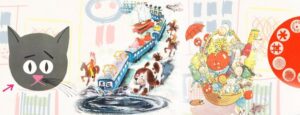
23 October 2020 will mark exactly 100 years since the birth of Gianni Rodari
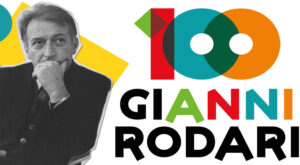
 Giovanni Rodari, called Gianni, (1920-1980) was a writer, pedagogist, teacher, journalist and poet specialising in children's literature. He is considered the greatest fairytale writer of the 20th century. After graduating as a teacher, he worked as a teacher for a few years before embarking on a career in journalism. He collaborated with numerous periodicals, including L'Unità, il Pioniere, and Paese Sera. Starting in the 1950s, he began publishing his works for children, immediately achieving great success with the public and critics. His books have had countless translations and have earned several awards, including, in 1970, the prestigious 'Hans Christian Andersen' prize, considered the 'Nobel' of children's literature. In the 1960s and 1970s, he participated in conferences and meetings in schools with teachers, librarians, parents and pupils. In 1973, he published the Grammar of Fantasy, a reference point for those involved in reading education and children's literature.
Giovanni Rodari, called Gianni, (1920-1980) was a writer, pedagogist, teacher, journalist and poet specialising in children's literature. He is considered the greatest fairytale writer of the 20th century. After graduating as a teacher, he worked as a teacher for a few years before embarking on a career in journalism. He collaborated with numerous periodicals, including L'Unità, il Pioniere, and Paese Sera. Starting in the 1950s, he began publishing his works for children, immediately achieving great success with the public and critics. His books have had countless translations and have earned several awards, including, in 1970, the prestigious 'Hans Christian Andersen' prize, considered the 'Nobel' of children's literature. In the 1960s and 1970s, he participated in conferences and meetings in schools with teachers, librarians, parents and pupils. In 1973, he published the Grammar of Fantasy, a reference point for those involved in reading education and children's literature.

Bibliography:
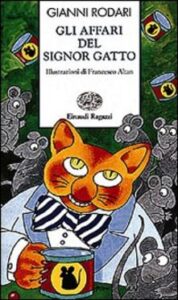 Gli affari del Signor Gatto: storie e rime feline / Gianni Rodari; illustrations by Francesco Altan. - Turin: Einaudi, 1995
Gli affari del Signor Gatto: storie e rime feline / Gianni Rodari; illustrations by Francesco Altan. - Turin: Einaudi, 1995
Rodari loved cats very much and planned an entire book of stories dedicated to them. His untimely death prevented him from producing the volume, but the writings collected here (some of which were recently found among Rodari's papers kept by his wife and published for the first time) give an idea of the amusing and entertaining project: a Mr Cat with a vocation for commerce, felines with unusual names and professions, astronomical claims to the name of a star, old men unhappy with their condition and ready to turn into cats.
 Atalanta: una fanciulla nella Grecia degli dei e degli eroi / Gianni Rodari; drawings by Emanuele Luzzati. - Rome: Editori Riuniti, 1985
Atalanta: una fanciulla nella Grecia degli dei e degli eroi / Gianni Rodari; drawings by Emanuele Luzzati. - Rome: Editori Riuniti, 1985
Abandoned in swaddling clothes on a mountain by her father, King Jaso, who wanted a son, little Atalanta is raised by a bear under the watchful eye of Diana, the goddess of the hunt. Becoming a strong and courageous young woman, she sets off to discover the world and performs extraordinary feats. Her courage, fortitude and integrity make heroes such as Theseus and Jason, whose respect and friendship she wins. For the first time, Gianni Rodari tackles the wonderful world of Greek mythology and tells, with his usual mastery, the story of a female character capable of leaving her mark even in the imagination of today's readers.
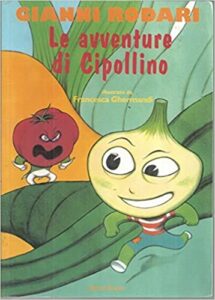 Le avventure di Cipollino / Gianni Rodari; illustrated by Francesca Ghermandi. - Rome: Editori riuniti, 2003
Le avventure di Cipollino / Gianni Rodari; illustrated by Francesca Ghermandi. - Rome: Editori riuniti, 2003
What is at stake in the clash between Onion and Lemon is nothing less than the freedom of an entire people, consisting of tomatoes, cherries, green beans and old moles. As enchanting as a fairy tale, as long as a novel, as funny as a cartoon, 'The Adventures of Onion' is a unique book, born in the atmosphere of enthusiasm and hope after the Second World War. The plot is straightforward: the good guys, harassed by the tyrant and oppressed by nonsensical rules, led by the young Cipollino manage to defeat the bad guys through jokes, hoaxes and ingenious plans, without ever resorting to violence. But Gianni Rodari's intention is not to stage a struggle between evil and good: it is to show that a just society is possible, desirable and also more fun for everyone.
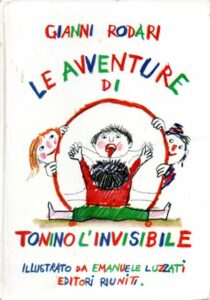
Le avventure di Tonino l'invisibile / Gianni Rodari; illustrated by Emanuele Luzzati. - Rome: Editori Riuniti, 1985
Every now and then we'd like to become invisible to play hooky from school, listen to what others say, play pranks without the fear of being punished. But if our dream were to become reality, we might run into the misadventures of Tonino, the protagonist of this delightful story, who soon realises the problems created by his desired and magical invisibility: not being able to play with his friends, being ignored by everyone, being alone... Once again Rodari with the lightness of the story makes us reflect on important themes such as friendship, participation and solidarity.
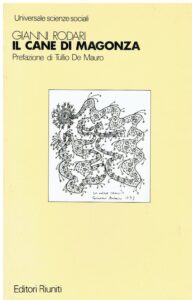 Il cane di Magonza / Gianni Rodari; edited by Carmine De Luca; preface by Tullio De Mauro. - Rome: Editori Riuniti, 1982
Il cane di Magonza / Gianni Rodari; edited by Carmine De Luca; preface by Tullio De Mauro. - Rome: Editori Riuniti, 1982
Gianni Rodari (1920-1980) was present in Italian and European culture not only as the author of famous and now classic texts in children's literature. First and foremost, Rodari was a journalist, reporter, correspondent, commentator and columnist. Of Rodari's composite catalogue of journalistic writings, this volume presents a rich selection. It is a Rodari in direct contact with reality, as always wittily ironic and satirical, and a lucid master of diffidence. To the pages of newspapers and periodicals Rodari assigned the task of also being a place for experimenting with new creative forms and procedures. In them he refined since the 1950s the strategies of satirical representation later used in his stories. A complete list of Rodari's writings in Paese sera, from 1958 to 1967, is attached to the volume.
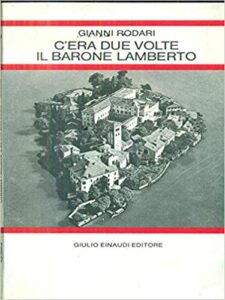 C'era due volte il barone Lamberto ovvero i misteri dell'isola di San Giulio / Gianni Rodari; edited by the author. - Turin: Einaudi, 1979
C'era due volte il barone Lamberto ovvero i misteri dell'isola di San Giulio / Gianni Rodari; edited by the author. - Turin: Einaudi, 1979
In the middle of the mountains is Lake Orta. In the middle of the lake is the island of San Giulio. On the island is the villa of Baron Lamberto, a very old, very rich gentleman, always ill. There are twenty-four illnesses and only his faithful butler Anselmo can remember them all... But in the meantime, the treacherous nephew Ottavio, who aims to seize his inheritance, and a gang of bandits determined to kidnap the baron and demand an enormous ransom, are swooping down on the island. Rodari's stories offer fun and a whirlwind of hilarious situations and characters: a way of understanding this world of ours.
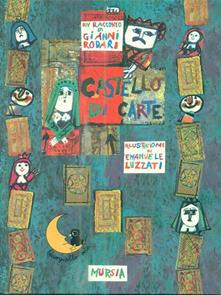 Castle of cards / Gianni Rodari; illustrations by Emanuele Luzzati. - Milan: Mursia, 1994
Castle of cards / Gianni Rodari; illustrations by Emanuele Luzzati. - Milan: Mursia, 1994
This rhyming story is a fable about power, freedom and contestation and begins with a King of Coins, the stingiest of all misers, and a queen, Mistress of Spades, the richest of all the rich.
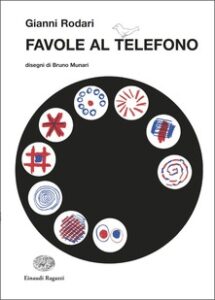 Favole al telefono / Gianni Rodari; drawings by Bruno Munari. - Turin: Einaudi, 1968
Favole al telefono / Gianni Rodari; drawings by Bruno Munari. - Turin: Einaudi, 1968
Gianni Rodari's 'Favole al telefono' do not know the passing of time: the non-conformist characters and unexpected events, the sweet chocolate streets and tasty ice-cream palaces, the paradoxical numbers and absurd questions that make the reader reflect are the strengths of that inexhaustible capacity for invention that Gianni Rodari combined with a precise observation of contemporary reality in the name of elegance, irony and freshness.
 Fiabe lunghe un sorriso / Gianni Rodari; illustrated by Emanuele Luzzati. - Rome: Editori Riuniti, 1996
Fiabe lunghe un sorriso / Gianni Rodari; illustrated by Emanuele Luzzati. - Rome: Editori Riuniti, 1996
Thanks to Gianni Rodari, children's literature has been removed from the limbo of a minor production and returned, in all its fascinating complexity, to the history of literature and the history of pedagogy. However, the Omegna writer's path does not take the form of a comfortable itinerary through the literary places of irony and paradox, and even less is it characterised as a path entirely within Italian pedagogical activism, but it gradually takes on the signs of contemporaneity, restlessness, moral tension and courageous civil protest. The humour of the absurd, the game of desecrating commonplaces, the twisting of language are nothing but the repeated invitation to free ourselves from schemes, prejudices and conformism in order to look further afield; at a time in history when moral and civil reference points seem to have been lost, Rodari's books show us, even beyond the happy invention and pleasure of reading, the paths of tolerance, the paths of friendship on which we must set out if we still want to bet on the future of the new generations.
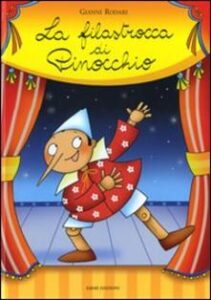 The Pinocchio nursery rhyme / Gianni Rodari; illustrations by Febe Sillani. - San Dorligo della Valle: Emme, 2009
The Pinocchio nursery rhyme / Gianni Rodari; illustrations by Febe Sillani. - San Dorligo della Valle: Emme, 2009
Published for the first time in serialized form in the 1950s and constructed through drawings commented by rhyming couplets, this nursery rhyme represents Rodari's homage to one of the best-loved characters for children all over the world. Faithful to the novel but capable of bringing it closer to the modern sensibility of children accustomed to storytelling through images, for decades it has unfailingly continued to win its bet: that of bringing even the youngest readers closer to Collodi's masterpiece.
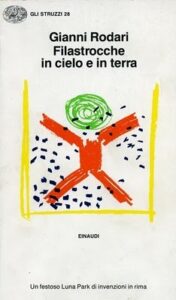 Filastrocche in cielo e in terra / Gianni Rodari. - Turin: Einaudi, 1982
Filastrocche in cielo e in terra / Gianni Rodari. - Turin: Einaudi, 1982
A colourful, constantly moving zoo, lifts that turn into spaceships, rocking accountants and armchair dynasties; disappearing accents, brackets left open, restless semicolons and commas, jaunty rhymes and neck-breakers: each of Rodari's books is a rendezvous with a cheerful, unbridled imagination that does not shy away from representing and judging the world.
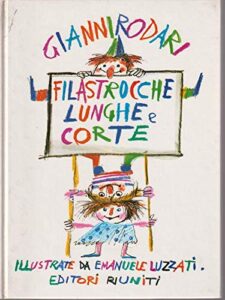 Filastrocche lunghe e corte / Gianni Rodari; illustrated by Emanuele Luzzati. - Rome: Editori Riuniti, 1984
Filastrocche lunghe e corte / Gianni Rodari; illustrated by Emanuele Luzzati. - Rome: Editori Riuniti, 1984
The protagonist of Filastrocche lunghe e corte is everyday life captured through glimpses of cities, seasons and characters that are sometimes realistic, sometimes imaginative, but always careful to lightly emphasise the value of work, respect for others, the importance of sincerity and the need for peace.
 Filastrocche per tutto l'anno / Gianni Rodari; illustrations by Emanuele Luzzati. - Rome: Editori Riuniti, 1986
Filastrocche per tutto l'anno / Gianni Rodari; illustrations by Emanuele Luzzati. - Rome: Editori Riuniti, 1986
It will be fun for readers to stay all year round in the company of Gianni Rodari: the nursery rhymes in this book touch on many aspects of everyday life and strike us as topical and fresh. Thanks to a skilful play of rhymes, the reader becomes the protagonist of the nursery rhymes, and if on the one hand Rodari invites the reader to look at himself in the mirror, on the other hand he does not fail to provide him with 'news stories', descriptions of towns and professions in poetry: with irony and lightness, Gianni Rodari makes us realise that the world needs everyone's commitment to friendship and solidarity.
 La freccia azzurra / Gianni Rodari; illustrated by Simona Mulazzani. - Rome: Editori riuniti, 2000
La freccia azzurra / Gianni Rodari; illustrated by Simona Mulazzani. - Rome: Editori riuniti, 2000
On Christmas night, all over the world, Father Christmas brings his gifts to children who have been good. The Italian ones are the luckiest, because on the night between 5 and 6 January they receive other gifts: flying on a broomstick, the Befana, a gruff but good old woman, brings them to them. But one 5 January many years ago, the Italian children were in danger of receiving no gifts at all. This is the starting point for a modern fairy tale animated by unforgettable characters, from the Freccia Azzurra train to Captain Mezzarba, from the little dog Spicciola to the Indian Silver Feather.
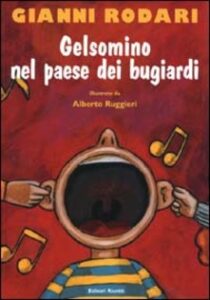 Gelsomino nel paese dei ligiardi / Gianni Rodari; illustrated by Alberto Ruggieri. - Rome: Editori Riuniti, 2000
Gelsomino nel paese dei ligiardi / Gianni Rodari; illustrated by Alberto Ruggieri. - Rome: Editori Riuniti, 2000
There exists who knows where and who knows when the land of liars, where bread is ink, where green is red, where dogs meow, where cats bark. Imagine what happens when in such a country comes Jasmine, who is used to calling a spade a spade.
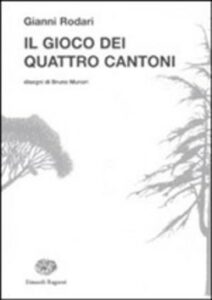 Il gioco dei quattro cantoni / Gianni Rodari; illustrations by Bruno Munari. - Turin: Einaudi, 1981
Il gioco dei quattro cantoni / Gianni Rodari; illustrations by Bruno Munari. - Turin: Einaudi, 1981
It contains the following short stories: Le mucche di Vitipeno; Un amore a Verona; Una vita per l'etologia; Le notti di Spilamberto; Le spiagge di Comacchio; Il gioco dei quattro cantoni; L'affare del secolo; Gente in treno; Codice di avviamento fantastico; Ciabattone e Fornaretto; Un giocattolo per Natale; La sposa sirena; Cielo e terra; La canzone del cancello; La parola Torino; La serenata di Pacchetto, La partita; L'agente X.99.
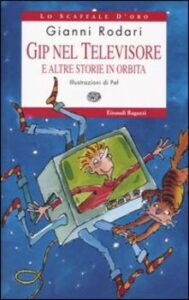 Gip nel televisore e altre storie in orbita / Gianni Rodari; illustrations by Pef. - Trieste: Einaudi Ragazzi, 2005
Gip nel televisore e altre storie in orbita / Gianni Rodari; illustrations by Pef. - Trieste: Einaudi Ragazzi, 2005
The very young Giampiero Binda, known as Gip, despite a great passion for television broadcasting, would never have thought of taking off from his armchair, plunging headlong into the magic apparatus and turning the most diverse programmes upside down! Yet in a quiet house in Milan, this is exactly what happens! In 'Other stories in orbit' we will instead get to know a souvenir seller who saves the Leaning Tower of Pisa from extraterrestrials, Delfina, the Cinderella of space, who is invited to the grand ball for the election of the President of Venus, and we can even go on holiday in Mr Pancrazio's flying house!
 La gondola fantasma / Gianni Rodari; illustrations by Francesco Altan. - Trieste: Einaudi, 2007
La gondola fantasma / Gianni Rodari; illustrations by Francesco Altan. - Trieste: Einaudi, 2007
A strange marriage between Venice and the Orient, puppet theatre and the 'Arabian Nights'. Harlequin, Columbine, Punchinello (with a nostalgia for Naples), Alì Badaluc, Magnapàn, Don Lindoro Lagrimoso, Pantalone dei Bisognosi and Captain Tartaglia, all busy chasing the mysterious ghost gondola that goes alone on the lagoon but could also transport the contentious son of the Caliph of Baghdad, Alì Mustafà, held prisoner in the infamous Piombi prison. Kidnappings, equivocal exchanges, escapes, piracy and, above all, the strange concept of honour of the mannered Mustafà (who also thanks for the beatings), until the festive 'happy end'. Illustrations by Altan.
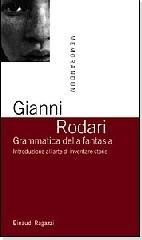 Grammar of the imagination: introduction to the art of inventing stories / Gianni Rodari. - Turin: Einaudi Ragazzi, 1997
Grammar of the imagination: introduction to the art of inventing stories / Gianni Rodari. - Turin: Einaudi Ragazzi, 1997
Grammar of Fantasy, one of Gianni Rodari's most important works and his only organic theoretical writing, was first published by Einaudi in 1973. The result of the 'Meetings with the Fantastic' that Rodari held in Reggio Emilia in March 1972 with teachers, librarians and cultural workers, it has always been a point of reference in Italy and abroad for those involved in reading education and children's literature. The history of this book is studded with re-editions and foreign versions that have ensured its international success, confirming its value and relevance to this day. In The Grammar of Fantasy, that human characteristic so powerful during childhood, imagination, becomes the engine of the creative process and comes to demonstrate the enormous liberating energy of the word. On the occasion of the fortieth anniversary of its first publication, a special edition is being published, enriched with 16 pages that gather the precious contributions of the author's friends, publishers, authors, and those who, although they did not know him personally, are indebted to him for a choice of life also thanks to his Grammar. Pino Boero, Roberto Denti, Roberto Piumini and many others have dedicated words of tribute to the figure of Gianni Rodari and his work.
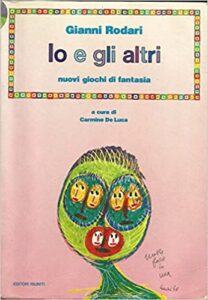 Io e gli altri: nuovi giochi di fantasia / Gianni Rodari; edited by Carmine De Luca; illustrations by Rosalba Catamo. - Rome: Editori Riuniti, 1988
Io e gli altri: nuovi giochi di fantasia / Gianni Rodari; edited by Carmine De Luca; illustrations by Rosalba Catamo. - Rome: Editori Riuniti, 1988
Here are the 'new fantasy games' proposed by Gianni Rodari with his stories, poems and plays. Why new? The first fantasy games, published in this same series under the title "Who am I?", helped the child to get to know himself. These new games bring him closer to the outside world, to reality, to others, friends or strangers, big and small, real or imaginary: together with them, the child sets off on another journey into fantasy land, where, as we know, there is room for everything and everyone.
 Il libro degli errori / Gianni Rodari; drawings by Bruno Munari. - San Dorligo della Valle: Einaudi Ragazzi, [2008].
Il libro degli errori / Gianni Rodari; drawings by Bruno Munari. - San Dorligo della Valle: Einaudi Ragazzi, [2008].
Gianni Rodari takes us on a paradoxical merry-go-round through the world of red and blue pencil corrections. Poems and short stories intertwine in a witty dialogue with intelligent schoolchildren (and parents, to whom the author dedicates a witty introduction to the book).
 Il libro dei perché / Gianni Rodari; ill. by Emanuele Luzzati. - Rome: Editori Riuniti, 1987
Il libro dei perché / Gianni Rodari; ill. by Emanuele Luzzati. - Rome: Editori Riuniti, 1987
'The game of whys is the oldest game in the world. Even before man learnt to speak, he had to have a big question mark in his head': Gianni Rodari's words clarify the meaning of the 'whys' in this book and take us inside a literary workshop where rationality and imagination, science and poetry coexist. Originating from two newspaper columns in which the writer answered the most varied questions of his young readers, the 'whys' once again give a measure of the greatness of Gianni Rodari, who with liveliness and irony knew how to make readers young and old think.
 Marionette in libertà / Gianni Rodari; illustrations by Paola. - Turin: Einaudi, c1974
Marionette in libertà / Gianni Rodari; illustrations by Paola. - Turin: Einaudi, c1974
Harlequin, Punchinello and Columbine, tired of being hung by a thread, decide to leave the Grand Puppet Theatre directed by Fernando Malvasia. Having escaped from the village of Telodomando, the three puppets embark on adventures and characters: a chattering salmon, a caged blackbird, a strict miller and some bears. But behind them, little by little, comes Malvasia... This first tale in verse, "Puppets in the wild" follows an amusing rewriting of Andersen's famous fairy tale, "The emperor's new dress".
 I nani di Mantova / Gianni Rodari. - Florence; Milan: Giunti Junior, 2000
I nani di Mantova / Gianni Rodari. - Florence; Milan: Giunti Junior, 2000
A book for early readers, full of colour illustrations and cute adventures. The dwarfs of Mantua have always lived in a special flat in the Ducal Palace, where everything is in miniature. But one day they rebel against Captain Bombard, go out and stay among the people because they have decided to grow up.
 Novelle fatte a macchina / Gianni Rodari; illustrations by Francesco Altan. - Trieste: Einaudi Ragazzi, c1998
Novelle fatte a macchina / Gianni Rodari; illustrations by Francesco Altan. - Trieste: Einaudi Ragazzi, c1998
A wise crocodile who shows up on television, Marco and Mirko against the fearsome Talcum gang, Grillo, the postman from Civitavecchia who lifts ships and the Colosseum, Piano Bill, the musical cowboy, sior Tòdaro, who for fear that Venice might sink at any moment turns into a fish... These are some of the unpredictable characters in this book by Rodari. "What would happen if", a magic key to penetrate the world of fantasy and imagination, is the question Rodari posed to the children of the many schools he often visited. What would happen if extraterrestrials descended on Pisa to steal the tower? Together, Rodari and the children tried and found the most bizarre answers. Thus was born this series of hilarious stories full of imagination and flair.
 Il pianeta degli alberi di natale / Gianni Rodari; illustrations by Francesco Altan. - Trieste: Einaudi Ragazzi, c1997
Il pianeta degli alberi di natale / Gianni Rodari; illustrations by Francesco Altan. - Trieste: Einaudi Ragazzi, c1997
Marco, the young protagonist of this novel, embarks on a long space voyage in the saddle of his pendant horse and discovers a fabulous planet where life has the colour of solidarity, the flavour of friendship: helpful robots fulfil the wishes of the inhabitants, technology is available to all, there are no conflicts. Gianni Rodari, who knew how to enter reality through the 'window' of fantasy, dedicates his planet 'to the children of today, the astronauts of tomorrow' and speaks to us with lightness and humour about important themes such as peace and science at the service of humanity.
 Little vagabonds / Gianni Rodari. - Rome: Editori Riuniti, 1987
Little vagabonds / Gianni Rodari. - Rome: Editori Riuniti, 1987
"Dear children, the difference between this story and a great adventure novel lies in the fact that everything here is true, from the first word to the last. In this story, I did not want to tell you incredible adventures, but how Anna, Francesco and Domenico gained their strength, how they became men day by day. The adventures of the pirates are more colourful and fascinating, of course: but the adventure of becoming a man is more beautiful, because it is truer."
 Prime fiabe e filastrocche / Gianni Rodari; illustrations by Francesco Altan. - Trieste: Edizioni E.Elle, 1993
Prime fiabe e filastrocche / Gianni Rodari; illustrations by Francesco Altan. - Trieste: Edizioni E.Elle, 1993
Have you ever encountered miraculous plants, extraordinary characters, geographical places born from imagination? Would you like to have fun with nursery rhymes entrusted to the game of rhyme, to the taste of invention, to the pleasure of storytelling? Open these First Fairy Tales and Nursery Rhymes by Gianni Rodari and read them... you will get to know an author who, from the very first years of his work as a journalist and children's writer, was able to bring forth from a reality that was still grey and poor opportunities for fun and reasons for reflection... a continuous explosion of fireworks and surprises.
 Il secondo libro delle filastrocche / Gianni Rodari. - Turin: Einaudi, printed 1985
Il secondo libro delle filastrocche / Gianni Rodari. - Turin: Einaudi, printed 1985
Che cosa succede se le formiche vanno in bicicletta, i gatti suonano il pianoforte, un ragioniere sposa una gallina ed un mercante si mette a vendere le stelle? Uno dei meriti di Gianni Rodari è quello di aver reso trasparente ai lettori di ogni età una verità importante: il gioco non è soltanto divertimento. Smontando, rimontando, combinando tra loro le parole ed i pezzi di quel gran meccano che è il mondo, noi impariamo a conoscerlo e a giudicarlo. Il <<bricolage>> della fantasia ci insegna a sorridere, e a capire. Pubblicate su giornali e periodici, e per la prima volta raccolte in volume (ma vi sono anche molti inediti), queste filastrocche aumentano il debito di gratitudine e di affetto per uno degli autori più amati degli italiani.
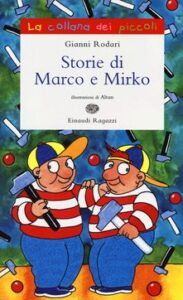 Stories of Marco and Mirko / Gianni Rodari; illustrations by Francesco Altan. - Turin: Einaudi Ragazzi, 1997
Stories of Marco and Mirko / Gianni Rodari; illustrations by Francesco Altan. - Turin: Einaudi Ragazzi, 1997
Many years ago, the twins Marco and Mirko would have given many worries to adults who, seeing them armed with terrible boomerang-hammers, would have feared damage to people and property. Today, on the other hand, the twins appear ingenious, enterprising, help adults, solve mysteries, and move with adventurous curiosity in that lively world built by Rodari's imagination.
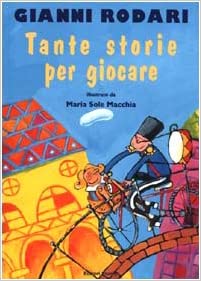 Tante storie per giocare / Gianni Rodari; illustrated by Maria Sole Macchia. - Rome: Editori Riuniti, 2000
Tante storie per giocare / Gianni Rodari; illustrated by Maria Sole Macchia. - Rome: Editori Riuniti, 2000
Tante storie per giocare (Many stories to play with) is one of the most famous 'fantasy exercises' that Gianni Rodari proposed to his very young audience: twenty stories for each of which three different endings are offered, with an explicit invitation to put one's imagination into play by inventing others. At the end of the book it is the author himself who comments on the different endings, introducing his readers to the workshop of a story inventor.
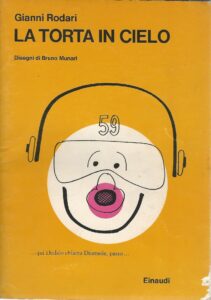 La torta in cielo / Gianni Rodari; illustrations by Francesco Altan. - Turin: Einaudi Ragazzi, 1995
La torta in cielo / Gianni Rodari; illustrations by Francesco Altan. - Turin: Einaudi Ragazzi, 1995
What if one day some kind of mysterious flying saucer appeared in the sky of one of our towns? Adults would immediately think of an invasion by extraterrestrials, call in the army, enlist legions of scientists and researchers... That's what happens in the Roman hamlet of Trullo, devastated by the mysterious space object... But two nice children don't believe in appearances, and the facts will prove them right: together with many friends, they will enjoy a wonderful cake that has descended from the sky.
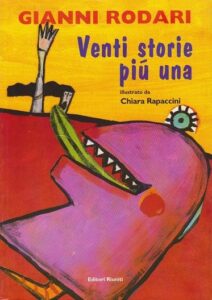 Twenty stories plus one / Gianni Rodari; illustrated by Chiara Rapaccini. - Rome: Editori Riuniti, 2000
Twenty stories plus one / Gianni Rodari; illustrated by Chiara Rapaccini. - Rome: Editori Riuniti, 2000
Teresin who did not grow up, magician Garù, King Midas and the brigand Filone, Uncle Bianco and Leo Decimo and many others are the protagonists of 'Twenty stories plus one', inhabitants of a world always poised between fairy tale and reality, between adventure and everyday life.
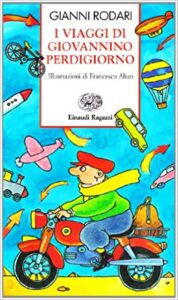 I viaggi di Giovannino Perdigiorno / Gianni Rodari; illustrations by Francesco Altan. - Turin: Einaudi, printed 1995
I viaggi di Giovannino Perdigiorno / Gianni Rodari; illustrations by Francesco Altan. - Turin: Einaudi, printed 1995
Giovannino Perdigiorno belongs to the lineage of great explorers: he has curiosity, a spirit of adventure, a desire to recount his exploits. The worlds he often encounters, however, do not completely satisfy him and so, after a short stop, he sets off again to pursue his dream of a 'country without error', where everything is 'perfect' and 'beautiful'.
Video:
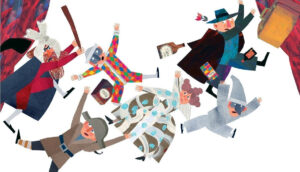
- Watch the first video: '100 years of Rodari', an unpublished film of him released
- Watch the second video: '100 years since the birth of Gianni Rodari'
- Watch the third video: "At school with Gianni Rodari".
- Watch the fourth video: 'Exercises in Fantasy'.
- Watch the fifth video: 'Rodari reads Rodari'
Insights:

- Read and know 1: Gianni Rodari in Enciclopedia dei ragazzi Treccani
- Read and know 2: Gianni Rodari in Wikipedia
- Read and know 3: Centogiannirodari.com
- Read and know 4: Gianni Rodari, a wonderful intellectual (Vannessa Roghi, historian)
Giovannino Perdigiorno 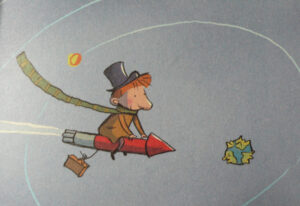
Giovannino Perdigiorno
has missed the midday tram,
he has lost his voice, his appetite,
he lost the will to lift a finger,
he lost his turn, he lost his quota,
lost his head (but it was empty),
lost his temper, lost his umbrella,
lost the key to the gate,
he lost his leaf, he lost his way:
all is lost but cheerfulness.
Recent articles
Archives
- Aprile 2024
- Marzo 2024
- Febbraio 2024
- Gennaio 2024
- Dicembre 2023
- Novembre 2023
- Ottobre 2023
- Settembre 2023
- Luglio 2023
- Giugno 2023
- Maggio 2023
- Aprile 2023
- Marzo 2023
- Febbraio 2023
- Gennaio 2023
- Dicembre 2022
- Novembre 2022
- Ottobre 2022
- Settembre 2022
- Agosto 2022
- Luglio 2022
- Giugno 2022
- May 2022
- April 2022
- March 2022
- February 2022
- January 2022
- December 2021
- November 2021
- October 2021
- September 2021
- August 2021
- July 2021
- June 2021
- May 2021
- April 2021
- March 2021
- February 2021
- January 2021
- December 2020
- November 2020
- October 2020
- September 2020
- August 2020
- July 2020
- June 2020
- May 2020
- April 2020
- March 2020
- February 2020
- January 2020
Categories
- Altri Post (291)
- News & Events (10)


